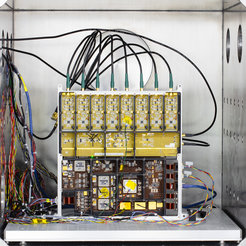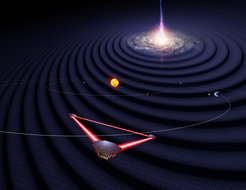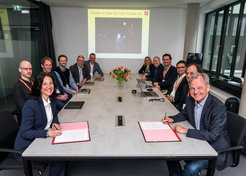Progress for LISA, the gravitational-wave observatory in space
AEI and OHB Systems AG have signed a contract for the further development and industrial production of LISA’s key measuring instrument.

To the point
- Progress for LISA: The gravitational-wave observatory is an ESA mission with the participation of NASA. It is scheduled for launch in 2035 and will gather entirely new information about the Universe.
- Key instrument: The phasemeter is the key instrument for LISA’s gravitational-wave observations. It was developed at the Max Planck Institute for Gravitational Physics
- Contract signed: The Max Planck Institute for Gravitational Physics and OHB Systems AG have signed a contract for the further development and production of the LISA phasemeter.

“LISA will be a mission of discovery and give us a completely new view of the universe,” says Karsten Danzmann, Director at the AEI. “With the phasemeter, the scientific heart of the mission is being developed and built in Germany. I am very pleased that the precision technology we have developed can also be used on other space missions, for example for Earth observation.”
LISA
LISA will be the first gravitational-wave observatory in space. It will consist of three satellites that will move in a triangular configuration in an Earth-like orbit around the Sun, while being connected by 2.5 million kilometer long arms of laser light.
LISA will be able to observe gravitational waves from sources in the entire Universe, almost back to the Big Bang. These gravitational waves will cause tiny length changes of the laser arms, smaller than the diameter of a single atom. LISA will measure these changes by monitoring the movements of test masses falling freely inside the satellites with laser light.
The phasemeter

The LISA phasemeter will detect the tiny changes (phase shifts) in the laser light caused by gravitational waves. It is therefore a key tool for observing these ripples in spacetime and learning more about their sources in the depths of the universe.
Development of the phasemeter began around 20 years ago at the Max Planck Institute for Gravitational Physics, with funding from the German Space Agency at the German Aerospace Center (DLR) and ESA. With funding from the German Space Agency at DLR, the final step was to develop the phasemeter to a technology readiness level that enabled the transition to industrial production.
OHB Systems AG in Oberpfaffenhofen has won a Europe-wide tender and is now taking on the next development stage. This involves developing the phasemeter to industrial product maturity for use under space conditions, initially in the form of an engineering model.
The further development and production of the phasemeter is a central German contribution to the LISA mission.
Phasemeters for geodesy from space
Phasemeter technology, which was developed for LISA, is also used in geodesy satellite missions such as GRACE Follow-On. These missions monitor the Earth’s gravitational field and provide information on the planet’s water balance, among other things. The phasemeter for the planned ESA geodesy mission NGGM will also be based on the developments at the Max Planck Institute for Gravitational Physics.
Background information
LISA research at the AEI
The institute has LISA research groups at its sites in Hannover and Potsdam. The institute plays a leading role in developing key hardware components, researching laser interferometry for LISA, and modeling sources, analyzing data, and using scientific results.
Gravitational-wave astronomy with LISA
Gravitational waves are ripples in spacetime that occur when masses are accelerated. Current detectors on Earth can measure gravitational waves originating from merging pairs of neutron stars and black holes with masses of up to several hundred times that of the Sun.
LISA will detect gravitational radiation in the yet unexplored window between 0.1 mHz and 1 Hz, waves that cannot be detected by ground-based detectors. Waves in this frequency range are created in the collision and merger of two massive black holes, a million or more times heavier than our Sun, lurking at the centers of distant, still forming galaxies. LISA will be sensitive to these mergers across the Universe's history, directly probing the yet unknown origin and growth of massive black holes. Unique to LISA is the detection of gravitational waves from stellar black holes swirling around massive ones in galactic nuclei, to probe the geometry of spacetime and test gravity in its foundations. LISA will also detect a large number of binary and multiple compact objects in our Milky Way galaxy to tell us about stellar binary evolution, and “see” the Galaxy beyond the Galactic Centre, including many objects invisible to all other astronomical instruments.
Since LISA is using only gravity for signals, it will complement our knowledge about the beginning, evolution and structure of our Universe. In addition, studying gravitational waves has enormous potential for discovering those parts of the Universe that are not yet observed such as the gravitational repercussions from the Big Bang, the ripples of spacetime emerging from perturbations of the primaeval plasma, and other, as yet unknown, objects. Working in conjunction with other astronomical methods and gravitational-wave observatories on Earth, LISA scientists will contribute to the next big discoveries to answer questions such as “What are the fundamental laws of the Universe?” and “How did the Universe originate and what is it made of?”














